 Facebook
Facebook
 X
X
 Instagram
Instagram
 TikTok
TikTok
 Youtube
Youtube
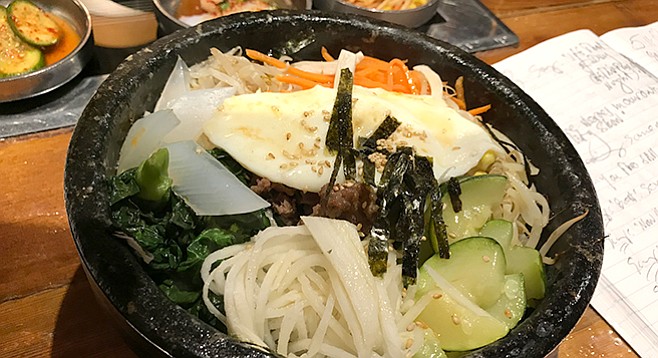
Almost didn’t make it out of Kearny Mesa Friday night. Caught the last bus by a hair.
I blame the Koreans. Came up here looking for Korean food. BBQ. And conversation. Because I’m kinda curious about what Korean-Americans are thinking about this whole Trump/Kim buddy movie going on. Also, what they think of North Korean food.
So I arrived at Convoy and Armour around 8:30. And, wow, looked like every place was packed. Manna Korean BBQ? Line out the door. DduriBa, Chon Ju Jip, ditto. The one hopeful place is Grandma’s. It’s crowded too, but the line waiting for tables looks shorter right now.
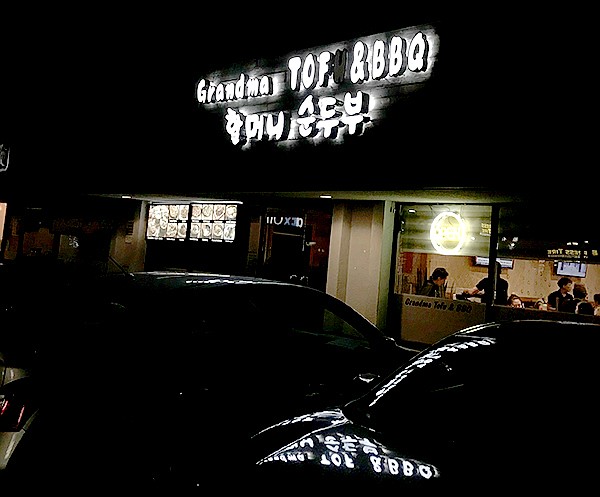
Lickety-split, I’m shuffling towards Grandma’s welcome desk behind a bunch of student-looking Korean guys. I ask them if they know any North Korean dishes. Uh-uh. “From what I hear, they hardly have any food at all,” says one of them.
Pretty soon, I’ve got me a table, and it has the BBQ area in the middle. Except, BBQ? The cheapest, chicken bulgogi (“fire meat”), is 18 bucks, and it goes up to $26 for “spicy galbi jjim, braised beef short rib with bone.” Combo for two costs $59.99.
The waitress comes along. “Number 47 is the most popular,” she says. I look. “Dolsot bibimbap. Mixed vegetables, beef, and egg over rice in a hot stone pot, $13.99.”
Things don’t get much cheaper elsewhere on the menu. So I order it, and a Korean beer, “Cass” ($6.99 for a 22-ounce bottle).
Menu says the bibimbap is served “with traditional Korean side dishes,” called “banchan.” And the waiter turns up with eight of them. I’m impressed. I see a fish cake, a savory-smelling lump of potato, seasoned bean sprouts, seaweed, cucumber kimchi, and a neat white cake of, uh, something.
Some are hot, some cold. Flavor-wise, I get tangy, savory, but also sweet.
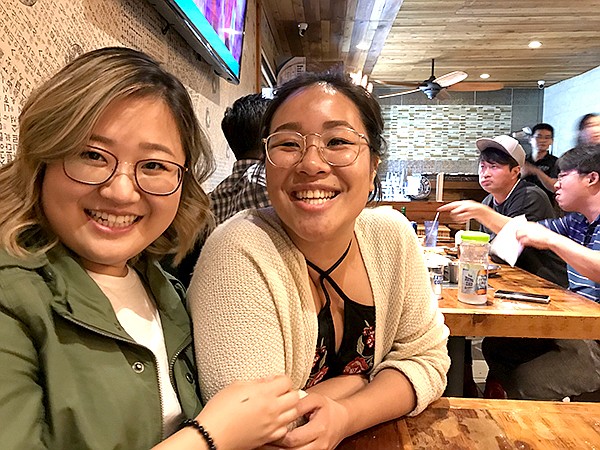
“Korean people like sweet,” says one of the gals at the next-door table. Mimi. Korean. Biology grad, UCSD. She and her friend Serena, who’s Chinese, always come here when one of them flies in from somewhere. Serena’s just landed from New York. Mimi’s eating seolleongtang, ox bone soup, ($11.99), and Serena’s got a spicy shredded beef soup, yukgaejang ($12.99).
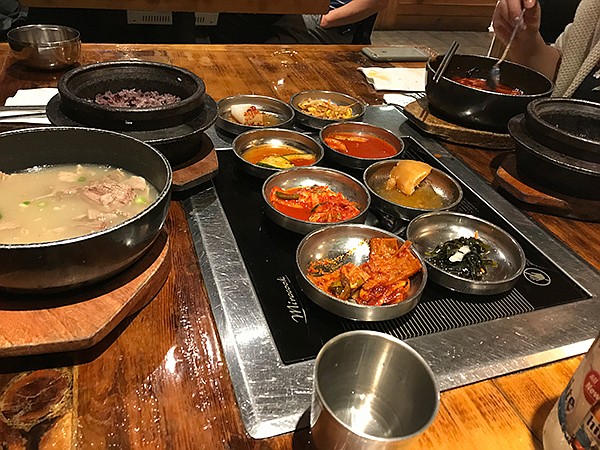
But now: wow. Here’s my thick black stone bowl, sizzling, loaded with smokin’-hot bibimbap. I’m seeing a big fried egg cooking on top, carrots, bean sprouts, some white noodles curled in a ball, seasoned cucumber chunks, spinach, looks like, and underneath, a dome of marinated beef, and underneath that, rice, and who knows what-all else.
I’m just about to start poking away with my chopsticks when Serena speaks up. “You are supposed to mix everything together, just before you eat it.”
Turns out bibim (“mix”) bap (“rice”) is a big collision of rice and namul, sautéed and seasoned vegetables. It has a long history in Korea. They say the dish evolved over many-a lunar new year’s eve, when people would throw their leftover food into a bowl of rice and eat it all so they could start their new year with a clean slate.
I mix mine into the sizzling black pot.
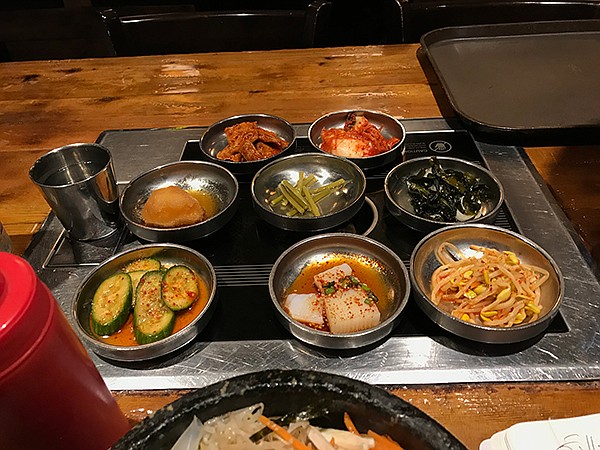
“Maybe some gochujang?” says Mimi. Oh yeah. The Korean red chili paste. It makes a glorious mess. Every now and then I reach for a banchan. The golden potato has this surprising savory-sweet taste. Other faves: the rich, sexy, unfishy fish cake slices, the cucumber kimchi, and something I’ve never had before, slabs of, uh, acorn jelly. Actual chunks made from acorns! Just like the Kumeyaay shawee. So it’s made on both sides of the Pacific? Huh.
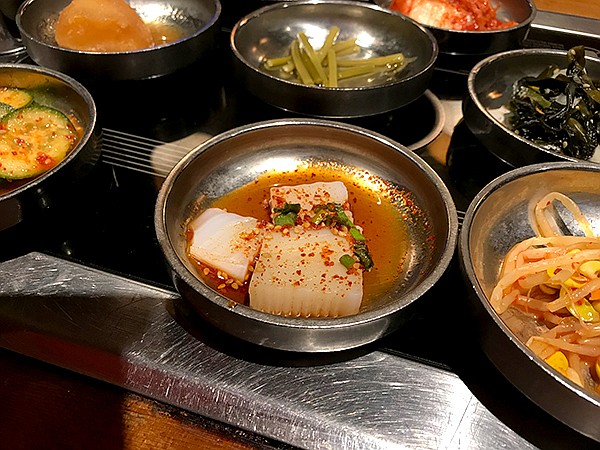
Plus, turns out there’s a lot of color symbolism in bibimbap. Black or dark colors (think shiitake mushrooms or bracken ferns) represent North, and, hey, your kidneys, too. Red or orange (chili, carrots, jujube dates) represent South, and the heart. Green (e.g. cucumber and spinach) is East, and the liver. White (e.g. bean sprouts, radish, rice) is West, and the lungs. And yellow (pumpkin, potato, egg) represents the center, or the stomach. So hey, eat this dish, you’re doing a symbolic tour of the universe, and your gut.
North Korean food? Just less sophisticated, says Serena. Good noodles, less flavorful. Generally less spicy than southern food. But the name “bulgogi,” the BBQ dish’s name, came from Pyongyang, the north’s capital.
Turns out Mimi has been really involved in the South Korean peaceful revolution that sent their recent lady president, Park Geun-hye, to jail. Mimi was actually out on the streets of Seoul, demonstrating, day after day, despite armies of police. Wasn’t she afraid?
“I was angry. We’re trying to end the corruption and have a fair democracy. And we won!”
She says she’s astonished that Trump and Kim look like upending 60 years of cold war. But reunification? She’s wary. “Look at how West Germany got drained when it reunited with East Germany,” she says.
We talk a lot, and the great thing is this dolsot — stone hot pot — has kept my bibimbap totally heated and just as good to eat as when we started yapping half an hour ago. And all that for $13.99, plus $6.99 for my Cass. Plus those eight banchan.
Mimi says honestly she feels more at home in California. But she still gets cravings for ‘Seoul Food’ in the middle of the night. “Mainly for chicken feet, and chon ju jip, marinated raw crab,” she says.
Hmm. Chon Ju Jip. Isn’t that the name of the restaurant nearby? Should check out their crab. Whatever, these gals are way too interesting. Ten minutes and a 100-yard sprint later, I scramble aboard the last #44 bus, sit down, and then, oh man: realize I forgot to scrape the bottom of the dolsot. The burned rice (nurungji) at the bottom of the hot pot is a favorite Korean delicacy.
Oh well. Great excuse to come back.
Hours: 10am - 11pm daily, (till 12am, Sunday night; till 10pm Monday)
Prices: Mulmandu boiled or fried pork dumpling (7 pieces), $6.99; japchae, stir-fried clear noodles, $13.99; kimchi soondubu (kimchi with pork tofu soup), $11.99; dolsot bibimbap (veggies, beef, egg, rice in a hot pot with 8 sides), $13.99; kimchi jjigae (stew, pork, tofu), $11.99; beef bulgogi (BBQ), rice, sides, $17.99
Buses: 27, 44, 60
Nearest bus stops: Convoy and Armour (44); Balboa and Convoy (27, 60)


Almost didn’t make it out of Kearny Mesa Friday night. Caught the last bus by a hair.
I blame the Koreans. Came up here looking for Korean food. BBQ. And conversation. Because I’m kinda curious about what Korean-Americans are thinking about this whole Trump/Kim buddy movie going on. Also, what they think of North Korean food.
So I arrived at Convoy and Armour around 8:30. And, wow, looked like every place was packed. Manna Korean BBQ? Line out the door. DduriBa, Chon Ju Jip, ditto. The one hopeful place is Grandma’s. It’s crowded too, but the line waiting for tables looks shorter right now.

Lickety-split, I’m shuffling towards Grandma’s welcome desk behind a bunch of student-looking Korean guys. I ask them if they know any North Korean dishes. Uh-uh. “From what I hear, they hardly have any food at all,” says one of them.
Pretty soon, I’ve got me a table, and it has the BBQ area in the middle. Except, BBQ? The cheapest, chicken bulgogi (“fire meat”), is 18 bucks, and it goes up to $26 for “spicy galbi jjim, braised beef short rib with bone.” Combo for two costs $59.99.
The waitress comes along. “Number 47 is the most popular,” she says. I look. “Dolsot bibimbap. Mixed vegetables, beef, and egg over rice in a hot stone pot, $13.99.”
Things don’t get much cheaper elsewhere on the menu. So I order it, and a Korean beer, “Cass” ($6.99 for a 22-ounce bottle).
Menu says the bibimbap is served “with traditional Korean side dishes,” called “banchan.” And the waiter turns up with eight of them. I’m impressed. I see a fish cake, a savory-smelling lump of potato, seasoned bean sprouts, seaweed, cucumber kimchi, and a neat white cake of, uh, something.
Some are hot, some cold. Flavor-wise, I get tangy, savory, but also sweet.

“Korean people like sweet,” says one of the gals at the next-door table. Mimi. Korean. Biology grad, UCSD. She and her friend Serena, who’s Chinese, always come here when one of them flies in from somewhere. Serena’s just landed from New York. Mimi’s eating seolleongtang, ox bone soup, ($11.99), and Serena’s got a spicy shredded beef soup, yukgaejang ($12.99).

But now: wow. Here’s my thick black stone bowl, sizzling, loaded with smokin’-hot bibimbap. I’m seeing a big fried egg cooking on top, carrots, bean sprouts, some white noodles curled in a ball, seasoned cucumber chunks, spinach, looks like, and underneath, a dome of marinated beef, and underneath that, rice, and who knows what-all else.
I’m just about to start poking away with my chopsticks when Serena speaks up. “You are supposed to mix everything together, just before you eat it.”
Turns out bibim (“mix”) bap (“rice”) is a big collision of rice and namul, sautéed and seasoned vegetables. It has a long history in Korea. They say the dish evolved over many-a lunar new year’s eve, when people would throw their leftover food into a bowl of rice and eat it all so they could start their new year with a clean slate.
I mix mine into the sizzling black pot.

“Maybe some gochujang?” says Mimi. Oh yeah. The Korean red chili paste. It makes a glorious mess. Every now and then I reach for a banchan. The golden potato has this surprising savory-sweet taste. Other faves: the rich, sexy, unfishy fish cake slices, the cucumber kimchi, and something I’ve never had before, slabs of, uh, acorn jelly. Actual chunks made from acorns! Just like the Kumeyaay shawee. So it’s made on both sides of the Pacific? Huh.

Plus, turns out there’s a lot of color symbolism in bibimbap. Black or dark colors (think shiitake mushrooms or bracken ferns) represent North, and, hey, your kidneys, too. Red or orange (chili, carrots, jujube dates) represent South, and the heart. Green (e.g. cucumber and spinach) is East, and the liver. White (e.g. bean sprouts, radish, rice) is West, and the lungs. And yellow (pumpkin, potato, egg) represents the center, or the stomach. So hey, eat this dish, you’re doing a symbolic tour of the universe, and your gut.
North Korean food? Just less sophisticated, says Serena. Good noodles, less flavorful. Generally less spicy than southern food. But the name “bulgogi,” the BBQ dish’s name, came from Pyongyang, the north’s capital.
Turns out Mimi has been really involved in the South Korean peaceful revolution that sent their recent lady president, Park Geun-hye, to jail. Mimi was actually out on the streets of Seoul, demonstrating, day after day, despite armies of police. Wasn’t she afraid?
“I was angry. We’re trying to end the corruption and have a fair democracy. And we won!”
She says she’s astonished that Trump and Kim look like upending 60 years of cold war. But reunification? She’s wary. “Look at how West Germany got drained when it reunited with East Germany,” she says.
We talk a lot, and the great thing is this dolsot — stone hot pot — has kept my bibimbap totally heated and just as good to eat as when we started yapping half an hour ago. And all that for $13.99, plus $6.99 for my Cass. Plus those eight banchan.
Mimi says honestly she feels more at home in California. But she still gets cravings for ‘Seoul Food’ in the middle of the night. “Mainly for chicken feet, and chon ju jip, marinated raw crab,” she says.
Hmm. Chon Ju Jip. Isn’t that the name of the restaurant nearby? Should check out their crab. Whatever, these gals are way too interesting. Ten minutes and a 100-yard sprint later, I scramble aboard the last #44 bus, sit down, and then, oh man: realize I forgot to scrape the bottom of the dolsot. The burned rice (nurungji) at the bottom of the hot pot is a favorite Korean delicacy.
Oh well. Great excuse to come back.
Hours: 10am - 11pm daily, (till 12am, Sunday night; till 10pm Monday)
Prices: Mulmandu boiled or fried pork dumpling (7 pieces), $6.99; japchae, stir-fried clear noodles, $13.99; kimchi soondubu (kimchi with pork tofu soup), $11.99; dolsot bibimbap (veggies, beef, egg, rice in a hot pot with 8 sides), $13.99; kimchi jjigae (stew, pork, tofu), $11.99; beef bulgogi (BBQ), rice, sides, $17.99
Buses: 27, 44, 60
Nearest bus stops: Convoy and Armour (44); Balboa and Convoy (27, 60)
Comments